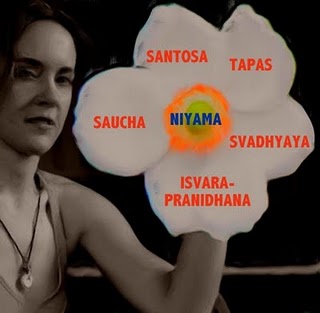Asteya: Non-Stealing
by Jennifer Fuller
Asteya “Non-Stealing” the third Jewel of Patanjali’s Yama’s
invites us to live in integrity and reciprocity. Well, it is not as simple as thou shall not steal thy
neighbor’s snow blower. It is far more complex, and requires deep introspection
with in each of us to fully unearth the true abundance, that lies beneath this
ethical precept. Asteya encourages students of yoga
to diminish their desire to rob energy, money, beauty, abundance, wealth, and
confidence from others, and instead turn inwards evaluating there own internal
resources. Students are encouraged to receive from others, but only that which
is freely given. The goal as a student of this long-standing tradition is to
surround oneself with people that are supportive of our betterment, and this
results is a treasure chest of absolute abundance, comparable to no wealth on
earth! In essence, the word Asteya is
rooted in integrity.
“Desire or want is the root cause of stealing” Swami
Sivananada
It is only by our
own nature that we look outside of ourselves in search of happiness. In this
search we end up in a game of comparison, envy, jealousy, all of which are a
forms of stealing. An individual is not only stealing from the other person
whom they have focused on, but they are stealing from themselves. We ultimately
lose sight of all of the blessings, and abundance that we have in our own lives
by comparing ourselves to other people. As a human being, it is so easy to get
caught up in the external high light reel of another’s life, but the problem
arises when we truly do not understand the individual’s situation or
circumstances. Our actions become harmful, such as slanderous words, harmful
statements, or just feelings of inferiority or superiority. Instead of embarking
on a mental journey of equality with each individual we encounter.
To practice Asteya we must as yoga practioner’s, students
and teachers alike, shed our layers, and remember we are united in community,
and we are all rich in our own divinity, which connects us all from a deep
source. We are here to support each other, build each other up, and lift each
other when we are down.
A key ingredient in acquiring
the ability to claim "integrity" in thought, word, practice, and
deed: humility.
Deborah Adele states in her book the Yamas and Niyamas,
‘That stealing from others we are comparing ourselves, which sends energy into
others lives in unhealthy ways. If we find ourselves lacking, we feel cheated
or slighted (less than), if we find ourselves superior we feel arrogant (better
than)”. We may act out these scenarios in an attempt to one up each other, or
put each other down through snide comments, talking behind someone’s back,
speaking frequently and highly of yourself without giving back or listening to
the other person.
As humans we are raised to take ownership of things; my car,
my house, my kids, my forest, my friends. But, through the study of Asteya we
begin to digest the concept that everything here on earth is not our possession,
and by staking claim or ownership, or property rights to people, places, or
material possessions we are stealing from the earth itself. These things; cars,
houses, friends, lakes, mountains, rivers, friends, and children they are mere
gifts. We begin to see that they are beautiful blessings that have been
bestowed into our lives filling them full of abundance. We do not own them, we
are simple stewards to them, and when we begin to shift our perspective we
begin to see the abundance that is truly encompassing our everyday lives. Then
we can begin to give back, and share this abundance with the world around us.
Stealing from yourself can also occur; this happens when we
put our selves down, part take in negative self talk, stop believing in
ourselves, lose motivation, self sabotage, experience low self esteem, place to
high of standards on ourselves, criticize ourselves, judge ourselves, lack will
power, lack self control, or part take in any other form of self abuse. Overcoming
this part of Asteya can be the most difficult! This is why it is most critical
to form a community, for all of us join together in support of one another, to
encourage each other and uplift one another.
Aadil Palhivala writes that the
"stealing" refers to the "stealing that grows from believing we
cannot create what we need."
This week practice a simple
self-evaluation on Asteya: First evaluate how you might be stealing from
others, where you might be comparing yourself to others, or placing yourself
either above someone, or below them. Begin to ask yourself why? Take a few
minutes to journal your reflections. Now can you shift and become a forklift
for those around you? Can you begin to lift up and give back to all those you
come into contact with, so that everyone whom you encounter this month feels
uplifted when they are around you?
Remember you have everything you
need, and the universe has your back! You are always supported and always
loved!












